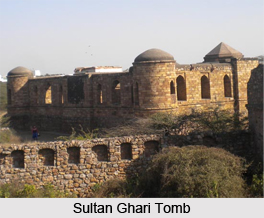 History of Sultan Ghari dates back to the period around 1231 AD, when it was constructed for the Islamic prince named Nasiru`d-Din Mahmud who was the eldest son of Iltutmish, one of the rulers of the Slave Dynasty. Sultan Ghari is the oldest mausoleum in the country and is located in Malakapur village close to Vasant Kunj in Delhi. Iltutmish had conquered the eastern portion of India during 1225 AD in order to gain administrative control of the area of Lakhnauti which presently constitutes a ruined city in the state of West Bengal that is Gaur. The battle which ensued consequently made the then king of Bihar and Bengal lose to Iltutmish which led to the signing of a peace treaty between the ruler Izaz and Iltutmish. Izaz was compelled to pay a hefty amount of 80 lakh `tankas` or silver currency, along with 38 elephants, several coins issued by the name of Iltutmish, mint and eventually acknowledging Sultan Iltutmish`s monarchy over the area. Prior to his return to Delhi, Iltutmish subdivided the eastern India into Lakhnauti and Bihar, establishing Alauddin Masud Jani as his general in Lakhnauti. However, Lakhnauti`s rule was temporary as he was overpowered by Iwaz after Iltutmish`s departure.
History of Sultan Ghari dates back to the period around 1231 AD, when it was constructed for the Islamic prince named Nasiru`d-Din Mahmud who was the eldest son of Iltutmish, one of the rulers of the Slave Dynasty. Sultan Ghari is the oldest mausoleum in the country and is located in Malakapur village close to Vasant Kunj in Delhi. Iltutmish had conquered the eastern portion of India during 1225 AD in order to gain administrative control of the area of Lakhnauti which presently constitutes a ruined city in the state of West Bengal that is Gaur. The battle which ensued consequently made the then king of Bihar and Bengal lose to Iltutmish which led to the signing of a peace treaty between the ruler Izaz and Iltutmish. Izaz was compelled to pay a hefty amount of 80 lakh `tankas` or silver currency, along with 38 elephants, several coins issued by the name of Iltutmish, mint and eventually acknowledging Sultan Iltutmish`s monarchy over the area. Prior to his return to Delhi, Iltutmish subdivided the eastern India into Lakhnauti and Bihar, establishing Alauddin Masud Jani as his general in Lakhnauti. However, Lakhnauti`s rule was temporary as he was overpowered by Iwaz after Iltutmish`s departure.
Therefore, Prince Nasiru`d-Din Mahmud was asked to put up a bold fight against Iwaz, wherein Iwaz was conquered and killed in 1227 AD along with all his noblemen. The then Governor of the province of Lakhnauti then joined the Oudh region with Bihar and Bengal, after making Lakhnauti his official capital. Iltutmish was quite impressed by the prince`s valour and granted him the title of `Malik-us-Sharq` or King of the East. His reign was short but just after 18 months, Nasuru`d-Din Mahmud was executed. Iltutmish had built the Sultan Ghari tomb in the memory of the young prince during 1231 AD, which is located near the complex of the Qutub Minar. Iltutmish died in the year 1236 and his own tomb is situated near Qutab Minar.
Near Sultan Ghari is existent two tombs of the two other sons of Iltutmish named Muizzudin Bahram Shah who was killed during 1241 AD and Ruknuddin Feroze Shah who died in 1237 AD. Their regime was short-lived and they had reigned before and after the rule of their renowned sister Razia Sultan and were buried in different cenotaphs or `Chhatris`. While one of the Chhatris is completely in ruins the other had been conserved. Excavations conducted by the Archaeological Survey of India has revealed a stone lingam, an isolated mosque belonging to the era of the rule of Firoz Shah Tughlaq and also an inscription dating back to 1361 over the surface of a tank which had been dug out during a marriage. Certain scattered remnants of the Mughal Dynasty have also been discovered.



















